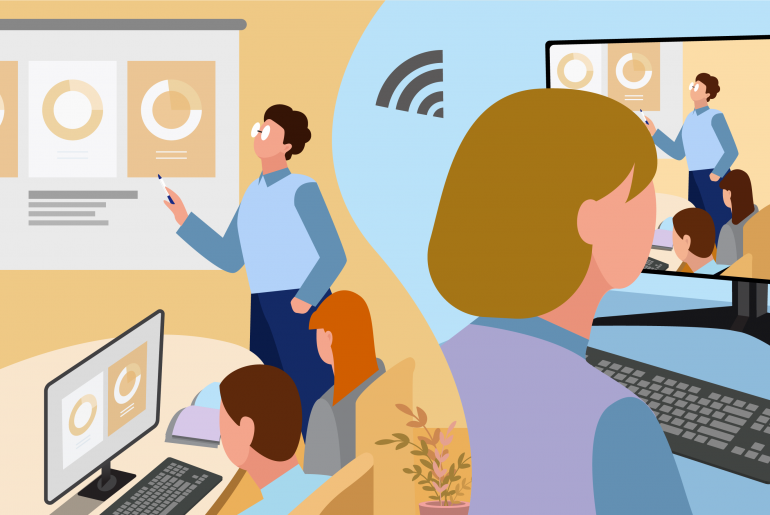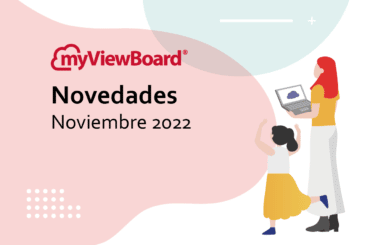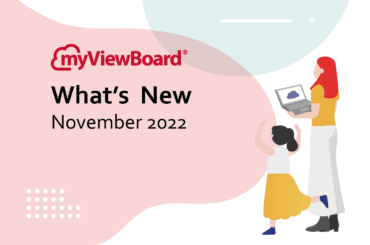This post is also available in: Español (Spanish) Français (French)
To truly get the most out of hybrid learning, students will need to make sure they adopt the right approach, get in the right mindset, have access to the right tools and equipment, and steer clear of some of the potential pitfalls. When this is achieved, hybrid classes can provide the benefits of both remote and in-person lessons at the same time, bringing education into a new and exciting age.
Continue reading to find out more about how to optimize your hybrid learning experience.
As a student, if you are able to get the most out of hybrid learning, you will be able to obtain the structure and social experience associated with classroom education, while also benefiting from the flexibility and sense of independence that distance education courses are able to provide. Nonetheless, there are certain things you will need to be aware of and steps you will need to take before you can actually benefit in such a comprehensive way.
Here, we examine some of the actions and approaches you can adopt to maximize what you get from hybrid learning.
Embrace the Flexibility
The first step towards ensuring you get the most out of hybrid learning is to make a conscious effort to embrace the flexibility it affords you. This flexibility is arguably the single most attractive feature of the hybrid approach, allowing you to learn remotely or in the classroom, based on your own preferences, as well as external factors.
Many learners will have a clear preference between remote learning and in-person learning, but the decision between the two is not always straightforward. For instance, there may be situations where you would rather be in a classroom setting, face-to-face with your teacher, in a shared space with other students, and able to embrace the social aspect of learning. Yet, there may be other points in time where the convenience of remote learning holds more appeal.
One of the truly great things about hybrid learning is the fact that it negates the need to make a one-off choice between these two approaches to learning and then stick rigidly to it. Instead, you will have the option to make an informed decision on a lesson-by-lesson basis, depending on your personal circumstances, what you are expecting from that particular lesson, your physical location, your well-being, and a range of additional factors besides.

Obtain the Right Equipment
Next, you are going to need to get hold of the right equipment to help you through your hybrid learning course. This will likely include a combination of things you will use to help you study remotely and things you will use in the classroom, but it may be that you are able to use the same basic equipment in both situations. As a starting point, if you intend to study from home, you should invest in a desk and chair, which can serve as a workstation.
In most cases, you are going to require a laptop, which will be used when you are in the classroom. Depending on what equipment you have access to at home, you may also need to use this laptop for the remote learning component of hybrid learning too. For convenience and the ability to interact with other members of the class, it is also recommended that you invest in some high-quality noise-canceling headphones with a built-in microphone.
You are likely to need things like a smartphone, as well as word processing software, like Microsoft Word or Google Docs. However, you also need to give some thought to any course-specific tools and equipment you may need. For example, on a graphics design course it may be beneficial to obtain a graphics tablet, while if you are studying computer programming, you may need the relevant software to learn a specific programming language.
Use Digital Whiteboarding
Digital whiteboarding solutions can play a crucial role in helping both teachers and students to get the most out of hybrid learning. With hybrid learning being defined as an approach where both in-person and remote learning activities occur at the same time, digital whiteboarding is at the very heart of many of these classes and courses.
ViewSonic’s own digital whiteboarding solution, myViewBoard Classroom, allows teachers to easily engage with students who are present in class and those who are learning remotely, with options to switch between the two. Communication within a hybrid class is also possible through screen sharing, live chats, and similar technology.
Such a solution can also help you to access lessons on demand. This means if you become distracted, lose focus, miss a class through illness, or wish to re-visit a lesson for exam revision, the option is available. Moreover, digital whiteboarding can also help you to join in with classroom discussions, brainstorming exercises, and similar activities. This level of participation in active learning can be crucial for maintaining engagement while you learn.

Steer Clear of Social Isolation
With hybrid learning, one of the potential traps some students may fall into is the temptation to treat it like distance education by relying entirely on the remote learning component. Although that is a perfectly viable approach – and it may be ideal for some students – it could also lead to feelings of social isolation.
It is important to acknowledge at this stage that while remote learning offers numerous advantages, it is also an approach that has some negative aspects. For instance, according to a 2017 study, remote learning is more likely to lead to high student attrition rates. It is believed that one of the key factors in this is a lack of social interaction. Fortunately, hybrid learning does offer some solutions here that can make all the difference.
The aforementioned study from 2017 found that occasional physical attendance can help to reduce attrition rates and this is certainly possible with a hybrid model. Try to break up any extended periods where you learn remotely by attending the classroom from time-to-time. When you do, talk to your classmates and collaborate with them.

Final Thoughts
Hybrid learning is a relatively new concept, which has emerged in line with advances to EdTech, but it does offer some exciting possibilities. To get the most out of hybrid learning, however, you will need to make some adjustments to how you learn with classroom-only or remote learning-only courses. Assuming you can make these adjustments, adopt the right state of mind, and obtain the necessary equipment, hybrid learning can be extremely advantageous.




